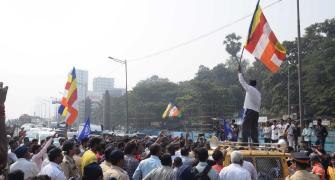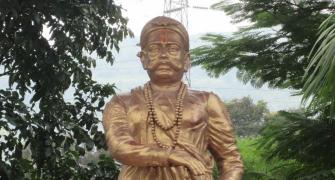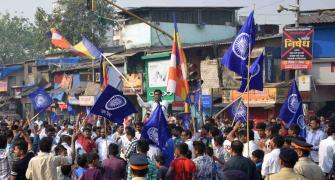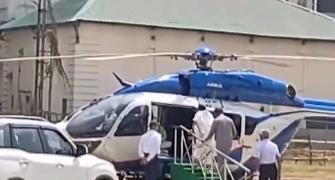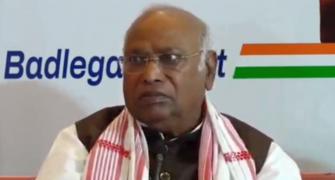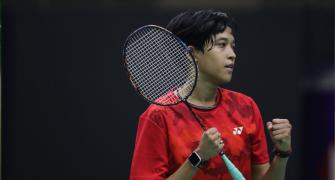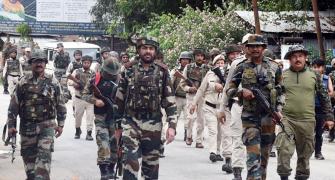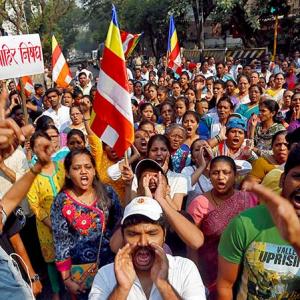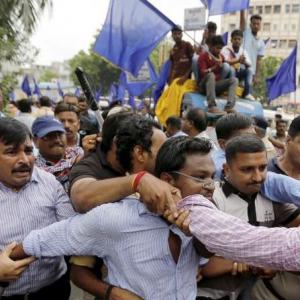'It is a reassertion of their lost martial stride, of a history that is papered over by turning it into a memory largely of the upper castes.'
Sadiya Upade reports.
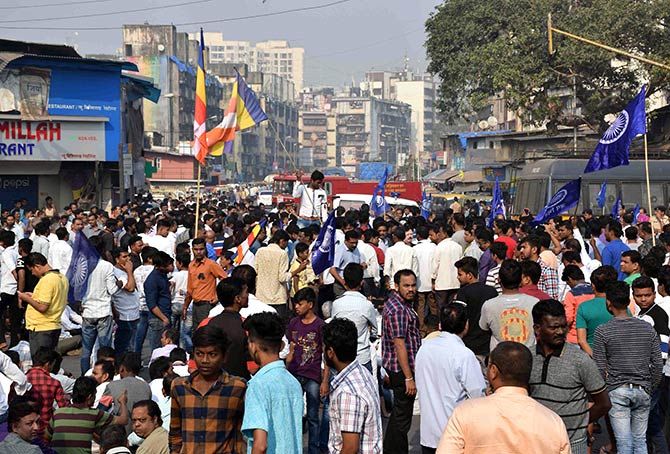
'This column is erected to commemorate the defence of Corigaum by a detachment commanded by Captain Staunton of the Bombay Establishment which was surrounded on the 1st of January 1818 by the Peshwas and withstood throughout the day a series of most obstinate and sanguinary assaults of his best troops.'
The marble plaques in English and Marathi, adorning the four sides of the obelisk, go on to declare that it was 'one of the proudest triumphs of the British army in the East.'
The memorial, just off a busy highway toll-collection booth, is not merely a colonial reminder though, but an assertion of Dalit history.
Deserted most part of the year, it comes alive on January 1 with members of the Dalit community from all over the country converging here for what has become an annual pilgrimage.
"Ever since B R Ambedkar visited the site in 1927, Mahars and other Dalits have been congregating at Bhima Koregaon every year. There's a festival-sort of atmosphere come New Year, with literature and pamphlets distributed," says Anirudh Deshpande, associate professor at the department of history, Delhi university.
Stalls selling Ambedkarite literature come up. There's recital of Buddhist verses and neo-Buddhist songs are played amidst calls of 'Jai Bhim'.
Outside the community though, there was little cognisance of the Bhima Koregaon battle, until violence marred its 200th anniversary and Dalit anger poured on to the streets across Maharashtra last fortnight.
The clashes between Dalit groups and alleged right-wing ones bought Mumbai, Pune and several towns to a standstill after a bandh call by the former.
Leaders of the Republican Party of India described the Pune violence as an attempt to create a rift between the Marathas and the Dalits, while reports said the fault lines between the two communities were open again.
The battle
Rewind to 1817.
The Peshwas were in retreat, significantly weakened after the two Anglo-Maratha wars.
The British had taken over much of their territory, and Pune was under the command of Colonel Charles Barton Burr.
At the end of December, Colonel Burr received information that Peshwa Bajirao II intended to attack Pune and he asked for help.
A battalion of Bombay Native Infantry, comprising mainly Mahar soldiers, under Captain Francis Staunton was dispatched.
While the numbers differ, it is estimated that the Peshwa camp had 25,000 to 30,000 men camped over the other side of the Bhima river.
Outnumbered with roughly 850 men, the Bombay Native Infantry fortified Koregaon, which already had mud walls, placing two artillery guns.
Three parties of 600 each -- Arabs, Gosavis and regular infantry -- were sent to take on the British troops as the Peshwa sat under an aftab-geer, a sun-shade, watching the fight. They managed to capture one of the company's guns and beheaded its commander.
The British put up a strong fight despite that, staving off the Peshwas for around 12 hours.
The Poona District Gazetteer records, 'As night fell, the attack lightened and they (the British) got water. By 9 the firing ceased and the Marathas left.'
It is said the Peshwa army ultimately withdrew, fearing the arrival of a larger British force led by General Joseph Smith.
The casualties were heavy on both sides, with the British losing around 275 troops and the Peshwa's army between 500 and 600 men.
Four years later, in 1822, the British erected a 60-foot commemorative obelisk.
Of the 49 names of the soldiers inscribed here, 22 are identified by their 'Nak' suffix as Mahars.
This suffix was used exclusively by the 'untouchables' of the Mahar caste who served as soldiers.
The obelisk has since been used as a testimony to the gallantry of Mahar soldiers.
Leaders such as Shivram Janba Kamble and Dr Ambedkar turned to it to evoke a sense of pride among the Dalits.
Differing viewpoints
There are differing viewpoints to the significance and narrative surrounding the battle.
Dalits believe that it can't be simply relegated to a battle between the British and the natives, but one where the Mahars (a Dalit faction) defeated the upper caste Peshwas.
Viewed from this prism, "the battle has grown on to become an important event in the Dalit Bahujan consciousness in India," says Deshpande.
Persecuted by the Peshwas, infamous for their high caste orthodoxy, the Dalits seized the opportunity and started enlisting with the British East India Company when it began recruiting for the Bombay army. They hoped this would open the doors for social emancipation.
The battle, won against the same Peshwas, is thus a reminder of the bravery and strength of the Mahars for them.
"It is a reclamation, a reassertion of their lost martial stride, of a history that is papered over or occluded by turning it into a memory largely of the upper castes," says Deshpande.
"It is in this context of 'who remembers what' that this battle assumes significance. By itself it was not noticed as a big victory by the contemporaries of that time. But the obelisk, raised years after the battle, has become a monument for the caste descendants of the Mahars."
Opponents, however, say it's wrong to bring the caste equation into what was a win by colonial rulers. They further argue that a majority of the Peshwa soldiers who fought at Bhima Koregaon were Arabs and not Marathas.
While Deshpande concedes that the social composition of the Maratha army had completely changed by the time of the second Anglo-Maratha war, with Arabs and North Indians in their fold, he argues, "Almost all Indian regiments are proud of their caste, of the fact that they are part of the martial races cultivated by the British."
"Their regimental traditions go back to the mid-18th century. If they can celebrate the victory of these regiments, who fought in the interests of the British, why can't the Mahars?"
Social change?
There are those who also point out that the win did nothing to change the social status of the Dalits.
In fact, after the 1857 uprising, the Mahars were declared a non-martial race and their recruitment stopped in 1892.
The Koregaon battle featured in all subsequent petitions to the British, underlying the bravery of the soldiers.
"When the theory of martial races began to gain weight from 1870 onwards, the so-called non-martial races were not recruited into the army anymore," says Deshpande.
"This happened with the Mahars and the Mazhbi Sikhs, who had served in large numbers before. Several petitions made to the government, asking them to open doors to the Mahars, contained references of the battles they had fought for the empire, including Bhima Koregaon. It, thus, started resurfacing as proof of the martial prowess of the Mahars," he explains.
The memorial, in fact, became a focal point, with Dalit leaders such as Kamble and Ambedkar holding meetings there.
As it turned out, the Mahars were inducted briefly during World War I, but the British stopped recruiting them again post the war. As a buoy, it kept resurfacing in attempts by Dalits to shed off caste oppression.
Ambedkar even made a reference to it during the Round Table Conference in 1931, as a representative of the untouchables.
Later, when Parliament did not accept the Hindu Code Bill he proposed, he converted to Buddhism as the only way to escape caste oppression.
Even today, Dalits are converting but at a slower pace, points out an IndiaSpend report -- perhaps because they are coming together to make their voices heard.
Photograph: Sahil Salvi


